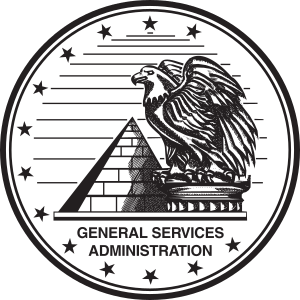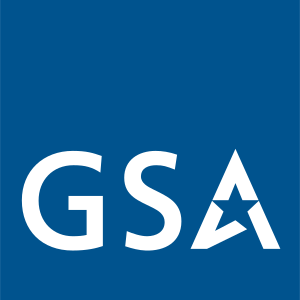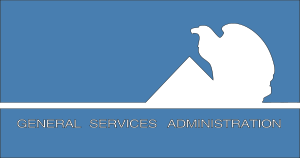General Services Administration facts for kids

Seal of the General Services Administration
|
|

Logo of the General Services Administration
|
|
 Flag of the General Services Administration |
|
| Agency overview | |
|---|---|
| Formed | July 1, 1949 |
| Headquarters | GSA Building 1800 F Street NW, Washington, D.C., U.S. |
| Employees | 11,137 (FY 2018) |
| Annual budget | $33.6 billion |
| Agency executives |
|
| Child agencies |
|
The General Services Administration (GSA) is a special part of the United States government. It was started in 1949. Its main job is to help other government agencies work smoothly.
GSA provides many things for government offices. This includes supplies, communication tools, and even cars for federal workers. They also find office spaces for government employees. GSA helps the government save money and manage things better.
About 12,000 people work for GSA. It manages a budget of around $33 billion each year. GSA also helps manage about $500 billion worth of U.S. government property. This includes 8,700 buildings and a fleet of 215,000 vehicles. One of the big buildings it manages is the Ronald Reagan Building and International Trade Center in Washington, D.C.. This is the second largest U.S. federal building, after the Pentagon.
GSA has two main parts: the Federal Acquisition Service (FAS) and the Public Buildings Service (PBS). It also has other offices that help with different tasks. For example, the Technology Transformation Services (TTS) helps government agencies use technology better. This includes programs like USA.gov, which helps people find government information and services online.
Contents
GSA's Story: How It Began
In 1947, President Harry S. Truman asked former president Herbert Hoover to lead a group. This group, called the Hoover Commission, suggested ways to make the government work better. One idea was to create a new office called the "Office of the General Services." This new office would combine several existing government groups.
These groups included:
- The U.S. Treasury Department's Bureau of Federal Supply
- The National Archives Establishment (which keeps important government records)
- All parts of the Federal Works Agency (which handled public buildings and roads)
- The War Assets Administration (which managed leftover war supplies)
GSA officially became an independent agency on July 1, 1949. This happened after a law called the Federal Property and Administrative Services Act was passed. General Jess Larson, who led the War Assets Administration, became GSA's first leader.
First Big Project: White House Renovation
GSA's very first big job was to completely fix up the White House. By 1949, the White House was in very bad shape. One inspector even said it was standing "purely from habit."
Jess Larson explained that they had to take almost everything apart inside the White House. Only the four stone outer walls were left standing. GSA worked closely with President Truman and First Lady Bess Truman. They made sure this huge project was a success. GSA finished the renovation in 1952.
Growing and Changing Over Time
In 1960, GSA created the Federal Telecommunications System. This was a phone system for government offices across the country. In 1962, a new building program started. It led to the construction of many government offices in Washington, D.C.
In 1970, the Consumer Product Information Coordinating Center was created. This center is now part of USAGov. In 1974, GSA started charging rent to federal agencies for the buildings they used. This created the Federal Buildings Fund.
GSA also helped with emergency preparedness and storing important materials for wartime. However, these jobs were later moved to the new Federal Emergency Management Agency (FEMA) in 1979.
In 1984, GSA introduced the use of charge cards for the federal government. This system is known as GSA SmartPay. In 1985, the National Archives and Records Administration became its own separate agency. That same year, GSA also started guiding how federal properties should be managed.
In 2003, the Federal Protective Service moved to the United States Department of Homeland Security. This service protects GSA-managed buildings. In 2005, GSA combined some of its business parts to create the Federal Acquisition Service (FAS).
Recent Developments
In 2013, GSA launched Data.gov. This website helps make government information available to the public. It was part of an effort to make government activities more open. That same year, GSA also started the Total Workplace initiative. This program helps modernize federal workplaces and make them more efficient.
In 2016, GSA launched the Acquisition Gateway. This helps federal agencies buy things. It also started the Making It Easier program to help new companies do business with the government.
How GSA Is Organized
GSA's Structure
The Administrator is the main leader of the General Services Administration. The President chooses this person. On April 12, 2021, President Joe Biden nominated Robin Carnahan to be the Administrator. The U.S. Senate approved her on June 23, 2021.
GSA has two main parts: the Federal Acquisition Service (FAS) and the Public Buildings Service (PBS). Besides these two, GSA also has twelve staff offices and two independent offices. The FAS helps other federal departments buy goods and services.
Past Leaders of GSA
| Name | Term start | Term end |
|---|---|---|
| Jess Larson | July 3, 1949 | January 29, 1953 |
| Russell Forbe (Acting) | February 10, 1953 | May 1, 1953 |
| Edmund F. Mansure | May 2, 1953 | February 29, 1956 |
| Franklin G. Floete | May 3, 1956 | January 20, 1961 |
| John Moore | February 7, 1961 | November 25, 1961 |
| Bernard L. Boutin | November 27, 1961 | November 30, 1964 |
| Lawson B. Knott Jr. | December 1, 1965 | February 28, 1969 |
| Robert Lowe Kunzig | March 17, 1969 | January 14, 1972 |
| Rod Kreger (Acting) | January 17, 1972 | June 1, 1972 |
| Arthur F. Sampson | June 2, 1972 | October 15, 1975 |
| Jack Eckerd | November 21, 1975 | February 11, 1977 |
| Robert Griffin (Acting) | February 15, 1977 | April 29, 1977 |
| Jay Solomon | April 30, 1977 | March 31, 1979 |
| Paul Goulding (Acting) | April 1, 1979 | June 29, 1979 |
| Rowland G. Freeman III | July 2, 1979 | January 14, 1981 |
| Raymond Adam Kline (Acting) | January 15, 1981 | May 25, 1981 |
| Gerald P. Carmen | May 26, 1981 | February 29, 1984 |
| Raymond Adam Kline (Acting) | March 1, 1984 | March 3, 1985 |
| Dwight Ink (Acting) | March 4, 1985 | June 28, 1985 |
| Terence Golden | June 29, 1985 | March 18, 1988 |
| Paul Trause (Acting) | March 19, 1988 | March 31, 1988 |
| John Alderson (Acting) | April 1, 1988 | September 26, 1988 |
| Richard Austin | September 27, 1988 | January 20, 1993 |
| Robert Jones (Acting) | January 20, 1993 | February 3, 1993 |
| Dennis Fischer (Acting) | February 4, 1993 | June 13, 1993 |
| Julia Stasch (Acting) | June 13, 1993 | July 7, 1993 |
| Roger Johnson | July 8, 1993 | February 29, 1996 |
| David J. Barram | March 4, 1996 | December 15, 2000 |
| Thurman Davis (Acting) | December 16, 2000 | May 30, 2001 |
| Stephen A. Perry | May 31, 2001 | October 31, 2005 |
| David Bibb (Acting) | November 1, 2005 | May 30, 2006 |
| Lurita A. Doan | May 31, 2006 | April 30, 2008 |
| David Bibb (Acting) | May 1, 2008 | August 29, 2008 |
| James A. Williams (Acting) | August 30, 2008 | January 20, 2009 |
| Paul F. Prouty (Acting) | January 20, 2009 | December 21, 2009 |
| Stephen R. Leeds (Acting) | December 22, 2009 | February 6, 2010 |
| Martha N. Johnson | February 7, 2010 | April 2, 2012 |
| Daniel M. Tangherlini (Acting) | April 3, 2012 | July 4, 2013 |
| Daniel M. Tangherlini | July 5, 2013 | February 21, 2015 |
| Denise Turner Roth (Acting) | February 22, 2015 | August 6, 2015 |
| Denise Turner Roth | August 7, 2015 | January 20, 2017 |
| Tim Horne (Acting) | January 20, 2017 | December 11, 2017 |
| Emily W. Murphy | December 12, 2017 | January 15, 2021 |
| Alison Brigatti (Acting) | January 15, 2021 | January 20, 2021 |
| Katy Kale (Acting) | January 20, 2021 | July 2, 2021 |
| Robin Carnahan | July 2, 2021 | incumbent |
Staff Offices
- Office of Government-wide Policy
- Office of the Chief Financial Officer
- Office of Human Resources Management
- Office of GSA IT (Information Technology)
- Office of Administrative Services
- Office of Congressional and Intergovernmental Affairs
- Office of Strategic Communication
- Office of Small Business Utilization
- Office of General Counsel
- Office of Civil Rights
- Office of Mission Assurance
- Office of Customer Experience
Independent Offices
- Office of Inspector General
- Civilian Board of Contract Appeals
GSA's Regional Offices
GSA has 11 offices across the United States. These are called GSA regions. They are located in cities like Atlanta, Boston, Chicago, Denver, Fort Worth, Kansas City (Missouri), New York City, Philadelphia, San Francisco, Seattle (Auburn), and Washington, D.C..
| Region | Region name | Complex | Location |
|---|---|---|---|
| 1 | New England | Thomas P. O'Neill Jr. Federal Building | Boston, MA |
| 2 | Northeast and Caribbean | 1 World Trade Center | New York, NY |
| 3 | Mid-Atlantic | 100 S Independence Mall W | Philadelphia, PA |
| 4 | Southeast Sunbelt | Martin Luther King, Jr. Federal Building | Atlanta, GA |
| 5 | Great Lakes | John C. Kluczynski Federal Building | Chicago, IL |
| 6 | Heartland | Two Pershing Square | Kansas City, MO |
| 7 | Greater Southwest | Fritz G. Lanham Federal Building | Fort Worth, TX |
| 8 | Rocky Mountain | Denver Federal Center | Denver (Lakewood), CO |
| 9 | Pacific Rim | 50 United Nations Plaza | San Francisco, CA |
| 10 | Northwest/Arctic | 1301 A Street | Tacoma, WA |
| 11 | National Capital | 1800 F St NW | Washington, DC |
What GSA Does
Buying for the Government: The GSA Schedule
The Federal Acquisition Service (FAS) helps federal agencies buy products and services. GSA has a special program called the GSA Schedule. Think of it like a big online store for government agencies. It has a list of pre-approved contracts.
Government buyers can look at these contracts and buy what they need. This makes buying things easier and faster for government offices. The GSA Schedule helps make sure the government gets good prices.
Managing Federal Buildings and Property
The Public Buildings Service (PBS) manages thousands of federal properties. GSA is in charge of setting rules for how the government buys, uses, and sells property. This includes land, buildings, and other items. These rules are made with other federal agencies.
PBS provides offices for federal agencies. It also provides United States courthouses. PBS gets its money mainly from the rent that federal agencies pay for their offices.
GSA also handles selling extra government property. This can include land, office buildings, warehouses, and even family homes. This extra property is offered to both government groups and private buyers. Sometimes, land sold for public uses, like parks, can be given at a big discount.
Many GSA buildings are "green buildings." This means they are designed to be good for the environment. They might have green roofs, use renewable power, or have special windows to let in natural light. In 2009, a law provided $4.5 billion to help GSA make its buildings even more energy-efficient.
In 2004, GSA received an award from the National Building Museum. This award recognized GSA for creating and maintaining good environments for federal workers and the public.
Managing Government Vehicles
GSA helps manage the U.S. government's vehicle fleet. This includes about 215,000 vehicles.
In 2009, a law provided $300 million to buy energy-efficient vehicles for the government. President Barack Obama announced that GSA would buy about 17,600 new fuel-efficient vehicles. This included 2,500 hybrid cars. This was the largest purchase of hybrid vehicles for the federal government at that time. Each new vehicle was expected to use at least 10% less fuel than older models.
GSA also bought some all-electric vehicles and hybrid buses. The government bought many Chevrolet Malibu Hybrids and Ford Fusion Hybrids.
Technology Transformation Services
GSA has a long history of helping people connect with government information. In 1970, the Federal Citizen Information Center was created. Later, in 2009, a new office was formed to use technology to serve the public better.
GSA also started programs like Presidential Innovation Fellows and 18F. These programs focus on making government digital services better. The Centers of Excellence, started in 2017, work to update government computer systems.
Now, all these efforts are part of the Technology Transformation Services (TTS). TTS is a part of the Federal Acquisition Service. Its goal is to make life better for people and government workers by improving how the government uses technology. TTS aims to help with things like buying technology, improving online experiences, and managing data.
TTS also includes:
- United States Digital Corps: A program for young technology experts to work in public service.
- TTS Solutions: A group of products and services that help agencies deliver information to the public.
Section 1122 Program
The Section 1122 Program allows state and local government agencies to buy defense equipment. This equipment helps with drug enforcement, homeland security, and emergency response. The Department of Defense manages this program. Equipment is provided by the Defense Logistics Agency and GSA.
See also
 In Spanish: Administración de Servicios Generales para niños
In Spanish: Administración de Servicios Generales para niños
- Building code
- Energy Efficiency and Conservation Block Grants
- Federal Building (disambiguation)
- Geographic Locator Codes
- GSA Advantage
- Public Works and Government Services Canada



